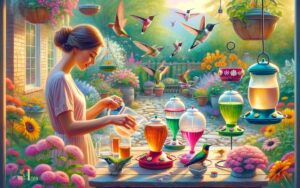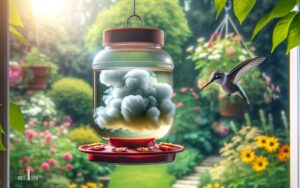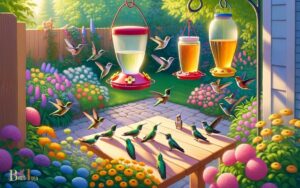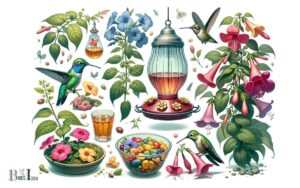How to Feed Hummingbirds Without a Feeder? 5 Easy Steps!
o feed hummingbirds without a feeder, create a garden with nectar-rich flowers, maintain a clean water source, and avoid pesticides.
Choose plants like bee balm, salvia, and trumpet vine that naturally attract hummingbirds. Additionally, ensure that your garden provides shelter and perching spots for these birds.
Feeding hummingbirds without a traditional feeder involves:
Attracting hummingbirds naturally enriches the ecosystem and provides a delightful spectacle of nature’s beauty in your garden.
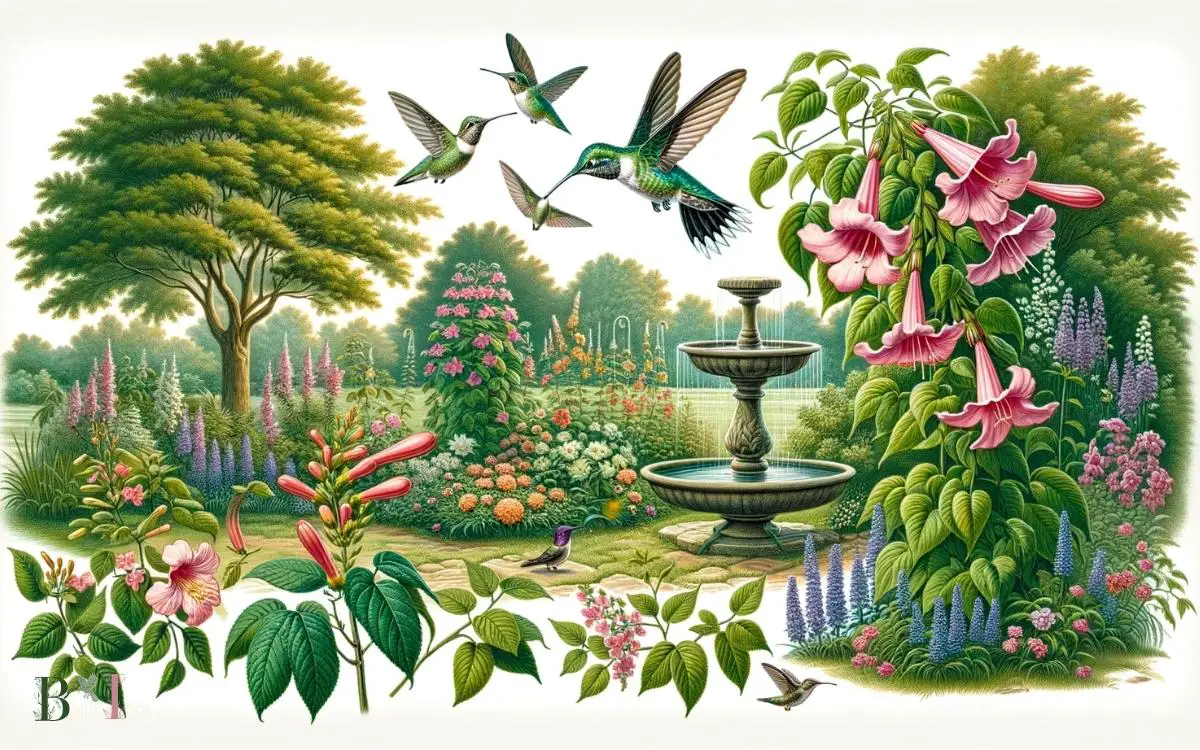
Key Takeaway
Step 1: Choose the Right Flowers
Select the appropriate flowers to attract and provide nourishment for hummingbirds without the use of a feeder.
When choosing flowers for hummingbirds, opt for nectar-rich blooms such as trumpet-shaped flowers like trumpet vine, bee balm, and columbine.
These flowers are a great source of nectar and are visually appealing to the hummingbirds. Additionally, include a variety of colors to attract a diverse range of hummingbird species.
Red, orange, and pink flowers are particularly attractive to hummingbirds. It’s important to ensure that the flowers bloom at different times throughout the season to provide a consistent food source for the hummingbirds.
By carefully selecting and planting these flowers, you can create a natural and sustainable way to nourish and attract hummingbirds without relying on a feeder.
Step 2: Make Your Own Nectar
To continue providing nourishment for hummingbirds without a feeder, it is important to make your own nectar using a simple recipe of sugar water.
To prepare the nectar, mix one part ordinary white granulated sugar with four parts warm water until the sugar is completely dissolved.
It is essential to use only granulated sugar as substitutes like honey, brown sugar, or artificial sweeteners can be harmful to the birds.
Boiling the water is not necessary, but it can help to ensure that the sugar dissolves completely. Once the nectar has cooled, it can be filled into clean, hummingbird-friendly containers.
Remember to change the nectar every 2-3 days, especially in warmer weather, to prevent fermentation and the growth of mold, thus ensuring the health of the hummingbirds.
Step 3: Provide Shelter and Perches
When attracting hummingbirds without a feeder, it’s important to provide them with shelter and perches.
Natural perching spots such as branches and twigs can be strategically placed throughout your yard to give hummingbirds a place to rest and observe their surroundings.
Planting dense shrubbery and hanging small shelters can offer protection from predators and harsh weather conditions.
Natural Perching Spots
Natural perching spots provide essential shelter and perches for hummingbirds to rest and observe their surroundings.
To attract hummingbirds without a feeder, it’s crucial to incorporate natural perching spots into your garden or outdoor space.
Trees, shrubs, and vines with dense foliage provide ideal shelter and perching spots for hummingbirds.
Planting native flowers with sturdy stems can also serve as natural perches. Additionally, installing trellises or creating small arbors can offer hummingbirds convenient perching locations.
By incorporating these natural elements, you can create a welcoming environment for hummingbirds to rest and observe their surroundings while also providing them with essential shelter.
Observing and understanding their natural behavior will help in creating a suitable habitat that meets their needs while also providing you with the joy of their presence.
Plant Dense Shrubbery
Hummingbirds rely on dense shrubbery to provide essential shelter and perches, creating a welcoming environment for them to rest and observe their surroundings.
Incorporating native flowers with sturdy stems and installing trellises or small arbors can offer convenient perching locations, contributing to a suitable habitat that meets their needs.
Ways to Create Shelter and Perches for Hummingbirds:
- Select Native Plants: Choose native shrubs and flowers with dense foliage to provide natural shelter and perching spots for hummingbirds.
- Install Trellises: Set up trellises or small arbors near nectar-producing plants to offer additional perching options for hummingbirds.
- Create a Layered Landscape: Design your garden with a variety of plant heights, including low shrubs and taller trees, to provide different levels of shelter and perches for hummingbirds.
Hang Small Shelters
To further create a hospitable environment for hummingbirds, consider hanging small shelters in the garden to provide additional perching and resting spots.
Hummingbirds expend a significant amount of energy and need places to rest and hide from predators.
Small shelters, such as half coconut shells or small wooden boxes, can offer protection from the elements and predators.
Place the shelters strategically around the garden, ensuring they are secure and stable. Incorporating perches near nectar sources allows hummingbirds to rest while keeping an eye on their feeding territories.
Providing these small shelters and perches not only offers a safe haven for hummingbirds but also allows for enjoyable opportunities to observe these fascinating creatures in a relaxed and natural setting.
Step 4: Set Up a Drip System
Setting up a drip system can be a great way to provide a consistent water source for hummingbirds.
This system offers benefits such as convenience, water conservation, and attracting a variety of bird species.
In the following section, we will discuss the installation process and key considerations for effectively implementing a drip system to support hummingbirds.
Drip System Benefits
Once properly installed, a drip system can provide a reliable and consistent source of nectar for hummingbirds.
The benefits of setting up a drip system for feeding hummingbirds include:
- Consistent Nectar Supply: A drip system ensures a steady supply of nectar, eliminating the need for frequent refills and reducing the risk of nectar scarcity for hummingbirds.
- Minimal Maintenance: Once the drip system is in place, it requires minimal maintenance, allowing you to focus on enjoying the presence of hummingbirds without constant upkeep.
- Attracts a Variety of Hummingbirds: The consistent nectar provided by a drip system can attract a diverse range of hummingbird species, enhancing the birdwatching experience.
Setting up a drip system not only benefits the hummingbirds by providing a reliable food source but also offers an opportunity for bird enthusiasts to create a welcoming environment for these beautiful creatures.
Drip System Installation
After understanding the benefits of a drip system for feeding hummingbirds, the first step in setting up a drip system is to select an appropriate location for installation.
Choose a spot that is easily accessible for maintenance and where the drip won’t be affected by strong winds.
Once the location is determined, follow these simple steps to set up a drip system for hummingbirds:
| Steps | Materials Needed | Tips |
|---|---|---|
| Choose Location | Drip tubing | Avoid direct sunlight |
| Install Tubing | Hose connector | Ensure steady flow |
| Set Up Dripper | Dripper stakes | Adjust for slow drip |
| Connect to Water | Pressure regulator | Prevent excess flow |
| Test and Adjust | Timer (optional) | Monitor regularly |
This easy-to-follow guide will help create a welcoming environment for hummingbirds without the need for a feeder.
Step 5: Hang Nectar-Filled Containers
You can attract hummingbirds by hanging nectar-filled containers in your garden. This simple method can provide a vital food source for these delightful creatures without the need for a feeder.
Here’s how to effectively hang nectar-filled containers to attract hummingbirds:
- Select the Right Containers: Use small, shallow containers with a secure hanging mechanism, such as glass jars or specially designed hummingbird feeders.
- Prepare the Nectar: Mix a solution of four parts water to one part sugar, and fill the containers with the nectar. Ensure the nectar is free of additives or dyes.
- Strategic Placement: Hang the containers in a shaded area, away from potential predators and other bird feeders, to create a safe and inviting space for hummingbirds to feed.
Maintain a Clean Feeding Area
To ensure the health and well-being of hummingbirds, it is essential to regularly clean and maintain the feeding area where nectar-filled containers are hung.
Cleaning the feeding area helps prevent the growth of mold and bacteria, which can be harmful to hummingbirds.
To maintain a clean feeding area, regularly wash the nectar containers with hot water and a small amount of vinegar to remove any residue.
Clean the surrounding area to remove any spilled nectar, as this can attract ants and other insects.
It’s important to inspect the feeding area regularly for any signs of contamination or spoilage, and to promptly clean and sanitize the feeding containers and the surrounding area as needed. B
y maintaining a clean feeding area, you can ensure that the hummingbirds have a safe and healthy environment to feed in.
Can Feeding Hummingbirds Without a Feeder Attract Ants?
Keeping ants away from hummingbird food can be a challenge, especially if you choose to feed them without a feeder. Ants are attracted to the sweetness of the nectar and can quickly swarm the area, making it difficult for hummingbirds to enjoy their meal. To deter ants, consider placing your hummingbird food on a platform with water moats or using ant guards on feeders to create a barrier.
Create a Hummingbird-Friendly Environment
Hummingbirds are attracted to environments with abundant nectar sources, diverse floral species, and suitable perching spots.
To create a hummingbird-friendly environment, consider the following:
- Plant native flowering plants: Choose a variety of native flowers with different bloom times to provide a continuous nectar supply.
- Provide perching spots: Install small branches or perches near the nectar sources, allowing the hummingbirds to rest and guard their feeding territories.
- Reduce pesticide use: Minimize the use of pesticides and herbicides in your garden to protect the hummingbirds and their food sources.
Conclusion
Feeding hummingbirds without a feeder can be accomplished through a variety of methods, such as choosing the right flowers, making your own nectar, providing shelter and perches, setting up a drip system, hanging nectar-filled containers, maintaining a clean feeding area, and creating a hummingbird-friendly environment.
By doing so, you can attract these beautiful creatures to your garden like a magnet drawing in metal filing

